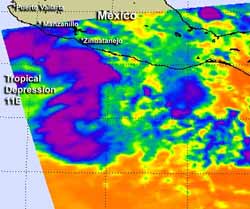NASA Gives Infrared Identification of New Eastern Pacific Tropical Depression

NASA's Aqua satellite captured an infrared image of developing System 90E on Sept. 11 at 3:47 p.m. EDT showing a very large area of strong thunderstorms (purple) on the western side of the center of circulation. System 90E organized more on Sept. 12 and was renamed Tropical Depression 11E. Credit: NASA/JPL, Ed Olsen<br>
The Atmospheric Infrared Sounder (AIRS) instrument onboard Aqua captured an infrared image of System 90E on Sept. 11 at 1947 UTC (3:47 p.m. EDT). That infrared image took the temperatures of the cloud tops and found some strong, high thunderstorms wrapped around the western side of the low pressure area's circulation, from north to south.
That area of thunderstorms had cloud top temperatures that exceeded the AIRS data -63 Fahrenheit/-52 Celsius threshold, indicating strong thunderstorms with heavy rainfall and a sign that the low was organizing. Less than 24 hours later, System 90E would be re-named Tropical Depression 11E, when the National Hurricane Center noted “It developed enough organized convection to be classified as a tropical depression.”
On Sept. 12 at 11 a.m. EDT Tropical Depression 11E had maximum sustained winds near 35 mph (55 kmh) and the National Hurricane Center noted that the depression could become a tropical storm tonight (Sept. 12) or Thursday, Sept. 13. Tropical Depression 11E was located near latitude 16.7 north and longitude 106.0 west, about 195 miles (315 km) southwest of Manzanillo, Mexico.
The depression is moving toward the west-northwest near 10 mph (17 kmh) and the National Hurricane Center expected it to continue in that direction over the next two days, moving away from the coast.
The Eastern Pacific Ocean is lagging behind the Atlantic Ocean in the development of tropical depressions this year. The fourteenth tropical depression in the Atlantic just strengthened into Tropical Storm Nadine.
Text Credit: Rob Gutro
NASA Goddard Space Flight Center, Greenbelt, Md.
Media Contact
All latest news from the category: Earth Sciences
Earth Sciences (also referred to as Geosciences), which deals with basic issues surrounding our planet, plays a vital role in the area of energy and raw materials supply.
Earth Sciences comprises subjects such as geology, geography, geological informatics, paleontology, mineralogy, petrography, crystallography, geophysics, geodesy, glaciology, cartography, photogrammetry, meteorology and seismology, early-warning systems, earthquake research and polar research.
Newest articles

A universal framework for spatial biology
SpatialData is a freely accessible tool to unify and integrate data from different omics technologies accounting for spatial information, which can provide holistic insights into health and disease. Biological processes…

How complex biological processes arise
A $20 million grant from the U.S. National Science Foundation (NSF) will support the establishment and operation of the National Synthesis Center for Emergence in the Molecular and Cellular Sciences (NCEMS) at…

Airborne single-photon lidar system achieves high-resolution 3D imaging
Compact, low-power system opens doors for photon-efficient drone and satellite-based environmental monitoring and mapping. Researchers have developed a compact and lightweight single-photon airborne lidar system that can acquire high-resolution 3D…





















